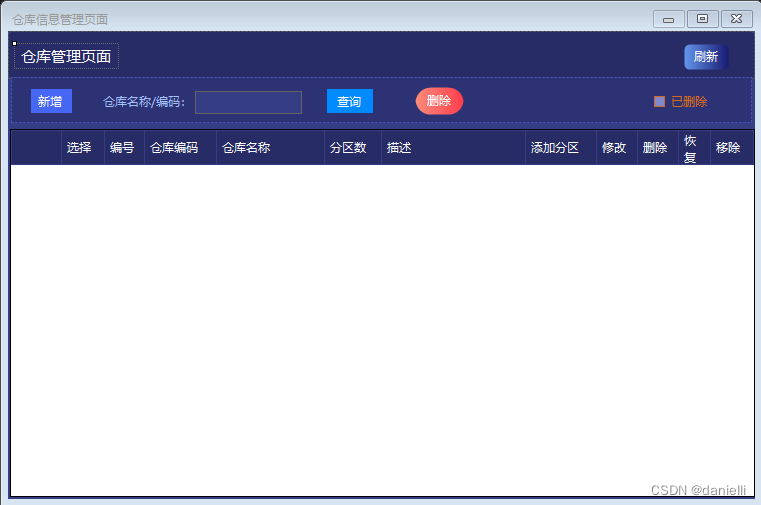在Windows Forms(WinForms)应用程序中,创建一个通用的管理页面通常涉及对数据的增删改查(CRUD)操作,以及一些额外的功能,如数据过滤、排序、导出和导入等。
先看一个仓库管理页面要素。

仓库管理页面的重点在LoadStore和修改, 代码如下:
using STMS.BLL;
using STMS.Models.DModels;
using STMS.STMSApp.FModels;
using System;
using System.Collections.Generic;
using System.ComponentModel;
using System.Data;
using System.Drawing;
using System.Linq;
using System.Text;
using System.Threading.Tasks;
using System.Windows.Forms;namespace STMS.STMSApp.store
{public partial class FrmStoreList : Form{public FrmStoreList(){InitializeComponent();}StoreBLL storeBLL = new StoreBLL();/// <summary>/// 页面加载/// </summary>/// <param name="sender"></param>/// <param name="e"></param>private void FrmStoreList_Load(object sender, EventArgs e){chkShowDel.Checked = false;txtKeyWords.Clear();LoadStoreList();}/// <summary>/// 查询仓库信息列表 /// </summary>private void LoadStoreList(){bool isDel = chkShowDel.Checked;string keywords = txtKeyWords.Text.Trim();dgvStoreList.ShowDgvCols(isDel);//显示操作列dgvStoreList.Columns["colAddRegion"].Visible = !isDel;//加载仓库数据 到数据库读取数据List<StoreInfo> storeList = storeBLL.GetStoreInfos(keywords, isDel);if(storeList.Count>0){dgvStoreList.AutoGenerateColumns = false;dgvStoreList.DataSource = storeList;SetEnableBtns(true);}else{dgvStoreList.DataSource = null;SetEnableBtns(false);}}private void SetEnableBtns(bool blShow){btnFind.Enabled = blShow;btnDelete.Enabled = blShow;}private void chkShowDel_CheckedChanged(object sender, EventArgs e){LoadStoreList();}/// <summary>/// 查询/// </summary>/// <param name="sender"></param>/// <param name="e"></param>private void btnFind_Click(object sender, EventArgs e){LoadStoreList();}/// <summary>/// 新增仓库信息--打开信息页面/// </summary>/// <param name="sender"></param>/// <param name="e"></param>private void btnAdd_Click(object sender, EventArgs e){ShowStoreInfoPage(1, 0);}/// <summary>/// 打开仓库信息页 新增、修改页面/// </summary>/// <param name="actTpye"></param>/// <param name="storeId"></param>private void ShowStoreInfoPage(int actTpye,int storeId){FrmStoreInfo fStore = new FrmStoreInfo();fStore.Tag = new FInfoData(){ActType = actTpye,FId = storeId};//刷新列表页数据效果 委托,采用事件fStore.ReLoadList +=()=> LoadStoreList();fStore.StartPosition = FormStartPosition.CenterScreen;fStore.ShowDialog();}/// <summary>/// 打开仓库分区信息页 添加分区/// </summary>/// <param name="storeId"></param>private void ShowStoreRegionInfoPage(int storeId){FrmStoreRegionInfo fRegion= new FrmStoreRegionInfo();fRegion.Tag = new FInfoData(){ActType = 3,FId = storeId};//刷新列表页数据效果 委托,采用事件fRegion.ReLoadStoreList += () => LoadStoreList();fRegion.StartPosition = FormStartPosition.CenterScreen;fRegion.ShowDialog();}private void dgvStoreList_CellContentClick(object sender, DataGridViewCellEventArgs e){var cell = dgvStoreList.Rows[e.RowIndex].Cells[e.ColumnIndex];//当前点击的单元格string headText = cell.FormattedValue.ToString();StoreInfo store = dgvStoreList.Rows[e.RowIndex].DataBoundItem as StoreInfo;switch(headText){case "添加分区"://打开添加仓库分区信息页ShowStoreRegionInfoPage(store.StoreId);break;case "修改"://打开仓库信息页ShowStoreInfoPage(2, store.StoreId);break;case "删除"://执行逻辑删除(假删除)DeleteStore(store,1);break;case "恢复"://恢复(逻辑删除的恢复)DeleteStore(store, 0);break;case "移除"://真删除 deleteDeleteStore(store,2);break;}}/// <summary>/// 删除/恢复/移除仓库信息/// </summary>/// <param name="storeInfo"></param>/// <param name="delCode"></param>private void DeleteStore(StoreInfo storeInfo,int delCode){string InfoName = "仓库信息";string delName = FormUtility.GetDelName(delCode);string msgTitle = $"{InfoName}{delName}";DialogResult dr= MsgBoxHelper.MsgBoxConfirm(msgTitle, $"你确定要{delName}该{InfoName}吗?");if(dr==DialogResult.Yes){bool bl = false;switch(delCode){case 1://逻辑删除int reDel= storeBLL.LogicDeleteStore(storeInfo.StoreId);if(reDel==1){bl = true;}else if(reDel==2){MsgBoxHelper.MsgErrorShow(msgTitle, $"该仓库已添加了分区,不能删除!");return;}else{bl = false;}break;case 0:bl = storeBLL.RecoverStore(storeInfo.StoreId);break;case 2:bl = storeBLL.DeleteStore(storeInfo.StoreId);break;}if(bl){MsgBoxHelper.MsgBoxShow(msgTitle, $"{InfoName} {delName} 成功!");LoadStoreList();}else{MsgBoxHelper.MsgErrorShow(msgTitle, $"{InfoName} {delName} 失败!");return;}}}/// <summary>/// 刷新 恢复最初状态/// </summary>/// <param name="sender"></param>/// <param name="e"></param>private void btnRefresh_Click(object sender, EventArgs e){chkShowDel.Checked = false;txtKeyWords.Clear();LoadStoreList();}/// <summary>/// 批量删除仓库信息/// </summary>/// <param name="sender"></param>/// <param name="e"></param>private void btnDelete_Click(object sender, EventArgs e){string msgTitle = "仓库信息删除";List<int> delIds = new List<int>();foreach(DataGridViewRow dr in dgvStoreList.Rows){StoreInfo store = dr.DataBoundItem as StoreInfo;DataGridViewCheckBoxCell chkCell = dr.Cells["colChk"] as DataGridViewCheckBoxCell;if(chkCell.FormattedValue.ToString()=="True"){delIds.Add(store.StoreId);}}if(delIds.Count >0){DialogResult dr = MsgBoxHelper.MsgBoxConfirm(msgTitle, $"你确定要删除选择的仓库信息吗?");if(dr==DialogResult.Yes){string reStr= storeBLL.LogicDeleteStore(delIds);if(reStr=="Y")//成功{MsgBoxHelper.MsgBoxShow(msgTitle, "选择的仓库信息删除 成功!");LoadStoreList();}else if(reStr.Length>=1&&(reStr!="Y"||reStr!="0"))//存在分区的仓库{MsgBoxHelper.MsgErrorShow(msgTitle, "选择的仓库信息中存在有已添加分区的仓库,它们的编号是:" + reStr);return;}else//删除失败{MsgBoxHelper.MsgErrorShow(msgTitle, "选择的仓库信息删除失败!");return;}}}else{MsgBoxHelper.MsgErrorShow(msgTitle, "请选择要删除的仓库信息!");return;}}}
}
下面是一个概述,说明如何实现一个通用的管理页面,以员工信息管理为例。
1. 设计用户界面
- DataGridView控件:用于展示数据表格,支持数据绑定和事件处理。
- TextBoxes和ComboBoxes:用于输入或选择数据,如员工姓名、职位等。
- Buttons:用于执行CRUD操作,如添加、编辑、删除和保存。
- Labels和Messages:用于显示提示信息或操作结果。
2. 实现数据绑定
- 使用ADO.NET(如SqlDataAdapter和DataSet)或Entity Framework来连接数据库。
- 将DataGridView与数据源绑定,确保数据能够实时更新。
3. CRUD操作
- 添加(Create):当用户点击“添加”按钮时,显示一个表单或对话框让用户输入数据,然后将数据插入数据库。
- 读取(Read):数据加载时,从数据库中读取数据并填充到DataGridView中。
- 更新(Update):允许用户直接在DataGridView中编辑数据,或通过弹出的编辑对话框进行修改,然后更新数据库。
- 删除(Delete):当用户选择一行并点击“删除”按钮时,从数据库中删除对应的数据行。
4. 高级功能
- 数据过滤和排序:允许用户通过ComboBox或TextBox过滤数据,以及通过列标题排序数据。
- 数据导出和导入:提供导出数据到Excel或CSV文件的功能,以及导入数据从这些文件。
- 权限控制:根据用户的权限显示或禁用某些功能,如只读访问或编辑权限。
5. 事件处理
- RowValidating:在用户试图保存更改之前,验证数据的完整性。
- RowUpdating:在数据更新到数据库之前,捕获更改并执行必要的逻辑。
- CellClick:当用户点击单元格时,显示详细信息或启用编辑模式。
6. 异常处理
- 在执行数据库操作时,应捕获并妥善处理异常,向用户提供友好的错误信息。
7. 界面美化
- 使用样式和主题来美化界面,如背景色、字体、图标等,以提高用户体验。
8. 性能优化
- 对于大数据集,考虑使用虚拟化和分页技术,避免一次性加载所有数据,提高应用程序的响应速度。
示例代码片段:添加员工信息
Csharp
1private void btnSave_Click(object sender, EventArgs e)
2{
3 using (SqlConnection connection = new SqlConnection(connectionString))
4 {
5 string query = "INSERT INTO Employees (Name, Position, Department) VALUES (@Name, @Position, @Department)";
6 using (SqlCommand command = new SqlCommand(query, connection))
7 {
8 command.Parameters.AddWithValue("@Name", txtName.Text);
9 command.Parameters.AddWithValue("@Position", cmbPosition.SelectedItem);
10 command.Parameters.AddWithValue("@Department", cmbDepartment.SelectedItem);
11
12 connection.Open();
13 int rowsAffected = command.ExecuteNonQuery();
14 if (rowsAffected > 0)
15 {
16 MessageBox.Show("员工信息已成功添加!");
17 // 刷新DataGridView
18 RefreshDataGridView();
19 }
20 else
21 {
22 MessageBox.Show("添加员工信息时发生错误。");
23 }
24 }
25 }
26}通过上述步骤,你可以构建一个功能齐全、易于维护的WinForms管理页面,用于处理各种类型的数据管理任务。




)

)

方法——判断字符串是否只由空格组成)
![[深入理解DDR] 总目录](http://pic.xiahunao.cn/[深入理解DDR] 总目录)


![[AIGC] 定时删除日志文件](http://pic.xiahunao.cn/[AIGC] 定时删除日志文件)
)


)

)
